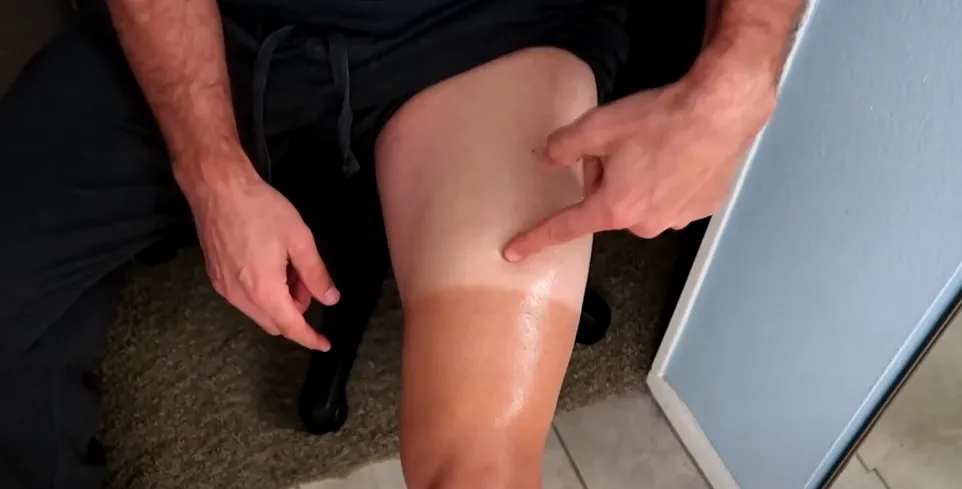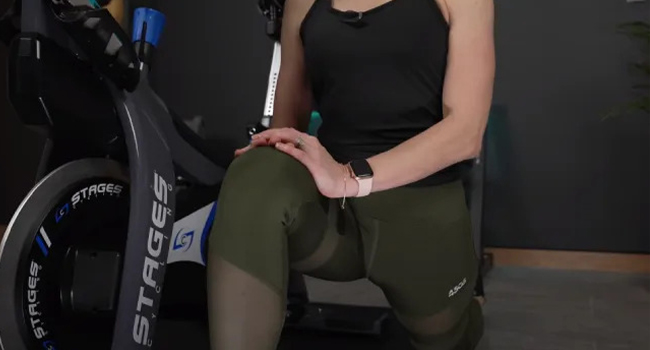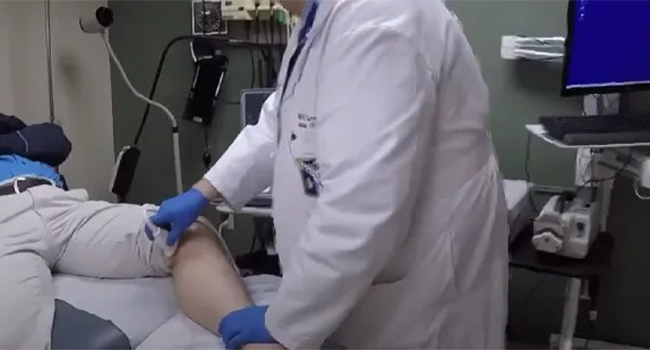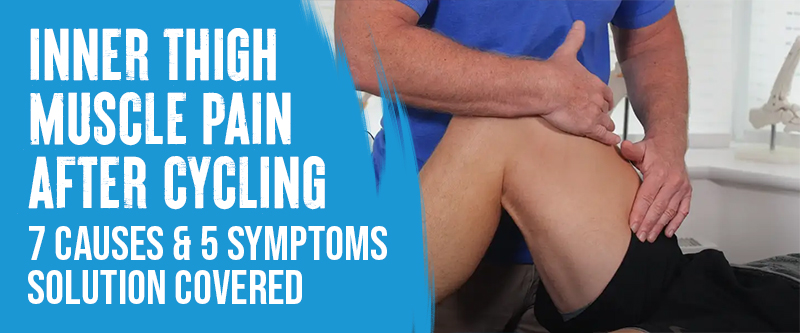After cycling, the adductor muscles (inner thighs) can become fatigued by sustained efforts, leading to soreness and discomfort. Cycling can also strain the inner thigh and groin area, resulting in sharp or pulling pain. Overstretching or tearing of muscles in this region may cause swelling, tenderness, and reduced range of motion.
Prolonged cycling can cause inner thigh muscle pain. The bike seat may be too hard for heavier people, leading to bone pain after cycling. While this may sound horrible initially, we’d like to emphasize that we’re talking about exceptional cases here.
This article delves deep into the causes, symptoms, diagnosis, treatment, and preventive strategies of inner thigh muscle pain after cycling, ensuring a smoother and pain-free ride for cycling enthusiasts worldwide.
Inner Thigh Muscle Pain After Cycling: 5 Key Symptoms

It’s common for cyclists to have muscle pain, particularly in the inner thighs. Mild soreness to severe pain, affecting performance and enjoyment. In this article, we’ll explore the causes of pain in the inner thighs after cycling and discuss potential solutions.
✔ Top Pick: Adjustable Bike Saddle
Many cyclists use an adjustable saddle to correct hip alignment and reduce inner thigh strain.
- Improperly Adjusted Saddle: An improperly adjusted saddle, whether too high or too low, can lead to inner thigh pain as it affects the positioning of the thighs during cycling. This misalignment can put stress on the inner thighs.
- Overutilization of Adductor Muscles: The adductor muscles in the inner thigh are heavily engaged during cycling to stabilize the hips and knees. Overusing these muscles can cause pain and discomfort.
- Incorrect Saddle Height: Cycling with a saddle set at the wrong height can lead to groin and inner thigh pain. Having the seat too low or too high increases pressure on the perineum, causing discomfort.
- Pudendal nerve irritation or Compression: Pudendal nerve irritation or compression can cause inner thigh pain during cycling. Understanding this possibility can help in addressing the discomfort.
- Iliotibial Band Friction Syndrome: Though commonly associated with knee pain, iliotibial band friction syndrome can manifest as inner thigh discomfort because of the IT band’s connection to the hip and thigh muscles. Proper stretching and strengthening exercises can ease this issue.
- Muscle Fatigue: Intense or prolonged cycling sessions, including those that involve the inner thigh muscles, can lead to muscle fatigue. Incorporating proper rest periods and recovery techniques can help prevent excessive muscle fatigue and subsequent pain. Intense physical activity, especially without proper stretching, can lead to muscle strains or tears in the inner thigh (adductor muscles).
- Groin Pain: Groin pain during or after cycling can radiate to the inner thigh region and may result from muscle strains, overuse, or improper bike fit. Addressing the underlying cause of groin pain can help ease associated inner thigh discomfort. Cycling numbness in the groin can be uncomfortable and concerning, but it’s a common issue among cyclists.
Inner thigh pain can arise from various conditions, each with its distinct mechanisms and implications for treatment. Below are detailed explanations of the causes you mentioned:
- Muscle Strain: Occurs when muscle fibers in the inner thigh are overstretched or torn. This injury is common among athletes or people who engage in vigorous physical activity without proper warming up or stretching.
The strain can cause pain, swelling, and reduced mobility in the affected area. The severity of a muscle strain is classified into three grades, ranging from mild to severe, which determines the extent of muscle fiber damage. An inner thigh muscle tear, especially involving the adductor group, can be painful and restrict mobility. The tears are usually caused by overuse, acute injury, or activities that require sudden changes in direction or intense physical exertion. - Hernia: A femoral hernia happens when fatty tissue or a part of the bowel protrudes through a weak spot in the abdominal wall near the femoral canal, which is close to the groin and inner thigh. It can cause pain in the inner thigh. It’s more common in women than men and may not always present visible symptoms until it becomes strangulated or incarcerated, leading to significant pain and potentially serious complications.
- Kidney Stones: While kidney stones primarily affect the kidneys, the pain can radiate to other areas, including the inner thighs. Kidney stones form from the crystallization of minerals and salts in the urine, which can block the urinary tract. The pain, known as renal colic, is intense and can spread to the lower abdomen, back, and thighs as the body attempts to pass the stones through the urinary system. The pain usually comes in waves and fluctuates in intensity.
5 Symptoms of Inner Thigh Muscle Pain After Cycling
The inner thigh muscle pain symptoms can be identified early and treated promptly. Let’s discuss the key indicators.
- Localized Pain: Cyclists may experience localized pain in the inner thigh muscles, which can vary in intensity from a dull ache to sharp discomfort. This pain typically occurs during or after cycling sessions.
- Tenderness to Touch: The affected inner thigh muscles may feel tender to the touch, showing inflammation or strain in the muscle fibers. This tenderness can be a common symptom accompanying inner thigh pain post-cycling.
- Stiffness and Restricted Movement: Inner thigh muscle pain results in stiffness, which restricts range of motion during activities like walking or bending. This stiffness can persist even when not cycling.
- Swelling and Discomfort: Swelling in the inner thigh area accompanied by general discomfort or tightness can show muscle strain or overuse, contributing to the pain experienced after cycling.
- Intensity and Duration: Inner thigh muscle pain in cyclists can vary in intensity and duration. Mild soreness can be relieved with rest and stretching, while severe and persistent pain may require further evaluation and treatment. Any changes in pain should be monitored closely.
Diagnosis of Inner Thigh Muscle Pain After Cycling
Diagnosing the specific cause of inner thigh muscle pain after cycling often requires a comprehensive evaluation by a healthcare professional. However, common diagnostic approaches and considerations for this type of pain may include:
- Physical Examination: The provider may conduct a physical examination to assess the affected area, evaluate muscle tenderness and range of motion, and identify any visible signs of swelling or inflammation in the inner thigh muscles.
- Medical History: Information concerning the onset of pain, cycling habits, previous injuries, and any other relevant medical history can help pinpoint potential causes of inner thigh discomfort.
- Imaging Studies: In some cases, imaging studies such as ultrasound, MRI, or X-rays may visualize the inner thigh muscles, joints, and surrounding structures. These images can help identify anomalies or damage contributing to the adductor pain.
- Electromyography (EMG): EMG may assess the electrical activity of the muscles in the inner thigh region. This test can help determine if any nerve-related issues contribute to the pain.
- Blood Tests: Blood tests can rule out inflammatory disorders or infections that could cause or exacerbate the pain.could cause or worsen the pain, like inflammatory disorders or infections.
- Consultation with Specialists: Depending on the findings of initial evaluations, a referral to specialists like sports medicine physicians, orthopedic surgeons, or physical therapists may be recommended for further assessment and tailored treatment plans.
Treatment and Management of Inner Thigh Muscle Pain After Cycling

You can stay active by cycling and exploring the great outdoors, but it’s not uncommon for cyclists to experience muscle pain, especially in the inner thighs. Here are some effective treatment and management strategies to help cyclists recover and get back in the saddle:
- Rest and Recovery: Allow the affected muscles to rest to promote healing and prevent further strain. Avoid cycling or activities that aggravate the pain until symptoms improve.
- Stretching and Strengthening Exercises: Perform gentle stretching exercises targeting the inner thigh muscles to improve flexibility and reduce tightness. Incorporate strengthening exercises to enhance muscle stability and prevent future injuries.
- Proper Bike Fit Adjustment: Ensure your bike is correctly fitted to your body measurements to ease pressure on the inner thigh muscles. Adjust saddle height and position as needed to minimize discomfort during cycling.
- Pain Management: Ice packs can reduce inflammation and numb the area, particularly after cycling sessions. Heat therapy can also help relax tight muscles. Consider over-the-counter pain relievers to manage pain and discomfort.
- Physical Therapy or Massage Therapy: A physical therapist can provide targeted exercises and techniques to treat inner thigh muscle pain. It can also relieve muscle tension and promote recovery.
- Addressing Underlying Medical Conditions: If the pain persists or gets worse, see your doctor to rule out any conditions that may contribute to the discomfort. Follow recommended treatment plans to address any identified issues.
Strategies for Preventing Inner Thigh Muscle Pain After Cycling
It’s essential to take steps to reduce inner thigh muscle pain, which can hinder performance and enjoyment. By incorporating preventive measures and knowing when to seek medical attention, cyclists can minimize the risk of injury and stay in top riding form. Here are some key prevention strategies:
Proper Warm-Up and Cool-Down Routines
Start each cycling session with a thorough warm-up to prevent injury. Incorporate dynamic stretches and light cardio exercises to increase blood flow and flexibility. Similarly, conclude your ride with a gentle cool-down to relax your muscles.
Gradual Increase in Cycling Intensity and Duration
Avoid sudden spikes in cycling intensity or duration, as this can lead to overuse injuries in the inner thigh muscles. Gradually increase your mileage, speed, or resistance over time to allow your muscles to adapt and strengthen.
Ensuring Proper Bike Fit
Invest in a professional bike fitting session to adjust your bike to your body proportions. A properly fitted bike can help prevent discomfort and strain on the inner thigh muscles by promoting an efficient riding position and optimal biomechanics.
Regular Stretching and Strengthening Exercises
Maintain flexibility and muscle balance with regular stretching and strengthening exercises. Exercises that target the inner thigh muscles, such as adductor stretches and leg lifts, improve muscle stability and prevent imbalances.
Listening to the Body and Avoiding Overtraining
Pay attention to your body’s signals to avoid injury and burnout. Allow for adequate rest and recovery between rides, and pay attention to fatigue or discomfort signs.
When to Seek Medical Attention?
While many cases of muscle soreness can be managed with rest and self-care, certain signs indicate the need for professional evaluation and treatment. Here’s when cyclists should seek medical attention for inner thigh muscle pain after cycling:
Persistent or Worsening Pain

If you experience persistent or worsening thigh pain despite rest and conservative treatments, seeking medical attention is essential. It may indicate an underlying condition or injury requiring further evaluation and treatment.
Pain Accompanied by Other Symptoms
Pay attention to any additional symptoms accompanying inner thigh muscle pain, like numbness, tingling, or weakness. These symptoms may indicate nerve compression or serious issues requiring prompt medical assessment.
Inability to Perform Daily Activities
Suppose inner thigh muscle pain significantly impairs your daily self-care or interferes with your quality of life. In that case, it’s crucial to consult with your doctor.
Massage Tips For Inner Thigh Muscles
Massaging the inner thigh muscles can effectively relieve tension, improve circulation, and facilitate muscle recovery, especially if you’re active or have sustained a minor injury. Here’s a comprehensive guide on how to perform a self-massage on your inner thigh muscles:
Positioning
Begin by finding a comfortable, quiet space to sit or lie down without interruptions. If sitting, extend the leg that requires the massage in front of you, ensuring easy access to the inner thigh. If lying down, slightly bend your knees with a pillow under the knee of the leg you’re massaging to allow better access to the thigh area.
Preparation
Warm up your hands by rubbing them together. This increases the comfort of the massage as cold hands can be shocking to the muscles. Optionally, apply a small amount of massage oil or lotion to your hands to reduce friction and make the massage more soothing.
Initial Contact
Place the knuckles of your right (or left hand, if more convenient) at the top of your inner thigh near the groin area. Your grip should be firm but not overly tight, allowing your knuckles to glide smoothly over your skin.
Movement and Technique
Press your knuckles into the muscle and start moving slowly, circularly. The movement should originate from the wrist for a more controlled massage. Begin with light pressure to warm up the muscle, accumulating the depth of your strokes as the muscle relaxes.
Conclusion
Inner thigh muscle pain after cycling is a common issue that affects many cyclists. The pain can be attributed to various factors, including an incorrectly adjusted saddle, overuse of the adductor muscles, improper saddle height, and more. Early detection and treatment can provide significant relief and prevent further complications.
Cyclists need to inform themselves about the causes, symptoms, and treatment strategies for managing this discomfort. Implementing preventive measures, including maintaining proper bike fit, exercising regularly, and listening to the body’s signals, can significantly reduce the risk of inner thigh muscle pain and help cyclists keep their optimal performance.
However, persistent or worsening pain, pain accompanied by other symptoms, or pain that significantly impairs daily activities should warrant a consultation with a healthcare professional. Our cycling journey should always prioritize safety and well-being as we continue to enjoy the many benefits of the sport.
FAQs
How Long Does It Take For Inner Thigh Muscle Pain To Go Away After Cycling?
Most pain will subside after a few days, but some causes can take longer. Inner thigh pain can usually be managed without medical treatment unless it results from a more serious health condition.
Can Tight Inner Thigh Muscles Cause Knee Pain?
Tight adductors can cause knee pain, especially in runners and cyclists. The adductor muscles pull the thighs together, rotate the upper leg inwards, and stabilize the hip.


